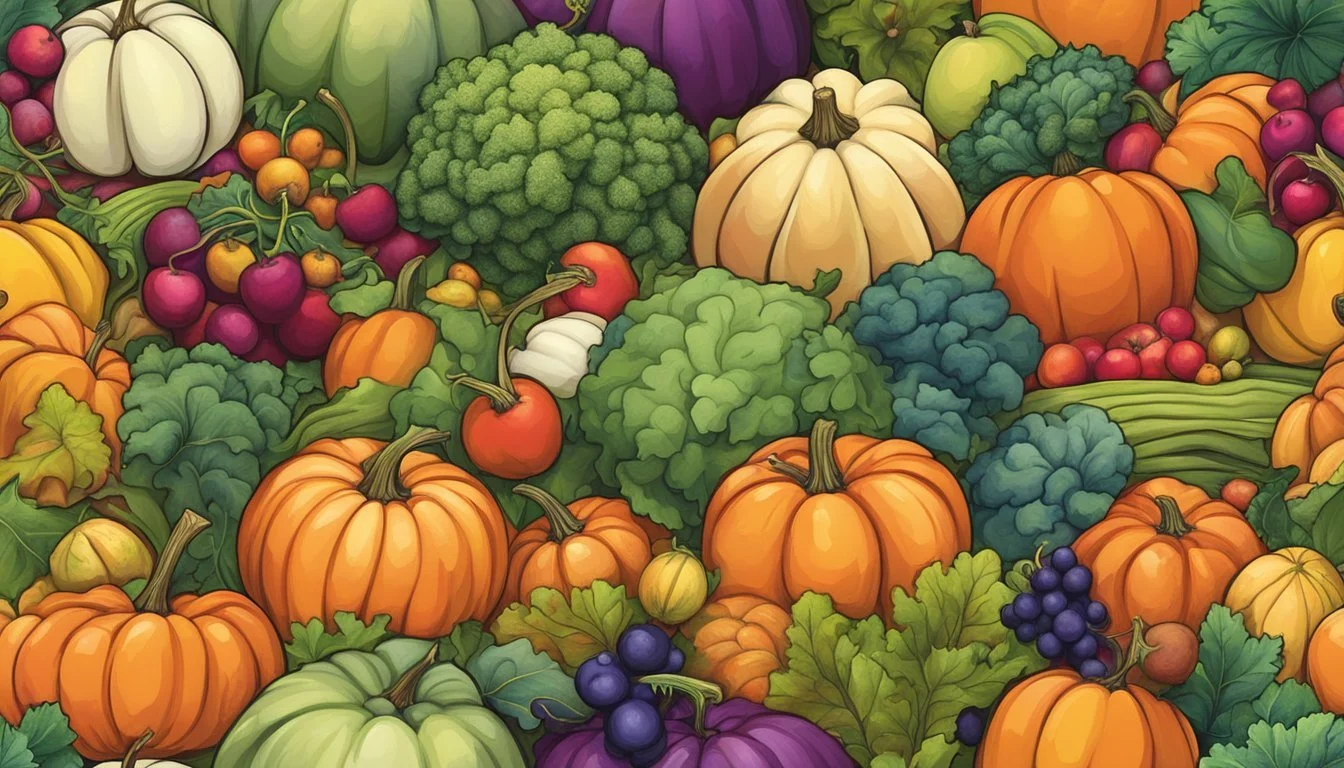Seasonal Fruit and Vegetables October
A Guide to Fresh Produce
This Article is Part of Our Guide to Seasonal & Local Produce in the USA
October marks a distinctive shift in the availability of fruits and vegetables as the transition from summer to autumn takes place. The month's cooler temperatures and shorter days cultivate a different bounty of produce, aligned with the season's palate. Root vegetables begin to take center stage, offering a range of earthy flavors and hearty textures suitable for robust fall dishes.
During this month, farmers' markets and grocery stores are stocked with an array of colorful and nutritious seasonal produce. Blackberries linger from their late summer peak, growing sweeter as the season progresses. They are joined by a variety of root vegetables such as beets, parsnips, and carrots, whose sweetness is enhanced by the colder soil. Trees yield quintessential autumn fruits like quince, a bonus find for those seeking something both unique and traditional for their October recipes.
Vegetables like broccoli (how long does broccoli last?) flourish in the crisp autumn air, offering vibrant green hues to the dinner table. Their nutrient-packed florets provide an excellent source of vitamins and minerals, perfect for boosting immunity as the colder months approach. Eating these seasonal offerings not only ensures peak flavor and nutritional value but also supports local agriculture and sustainable practices.
What’s in Season in October in Your State?
Texas Seasonal Fruit and Veg in October
Significance of Seasonal Produce
In the autumn months, consuming seasonal produce offers numerous benefits. Variety is one of them. Fall provides a bountiful selection of fruits and vegetables, each bringing its unique flavor, texture, and nutrition to the table. They enhance healthy eating habits by supplying fresh, nutrient-dense options.
Seasonal fruits and vegetables have a higher nutritional value when harvested at their peak. They contain more vitamins, minerals, and antioxidants, essential for maintaining good health. In October, the season's offerings include pumpkins, which are rich in beta-carotene, and cranberries, known for their vitamin C content.
Cost-effectiveness is another key aspect. When produce is in season locally, the abundance of the crop typically reduces costs, providing both economic and nutritional value to consumers. As an example, autumn's harvest brings an array of varieties from apples (how long do apples last?) to sweet potatoes (What wine goes well with sweet potatoes?), each at more affordable prices.
Lastly, seasonal produce supports sustainable practices. Local and seasonal food requires less transportation and storage, reducing its carbon footprint. It also encourages consumers to support their local farmers and economies.
Healthy Choices: Fruits like blackberries become sweeter and less tangy.
Sustainable: Less transportation is required for local produce.
Economical: Seasonal abundance often leads to lower prices.
Varietal Richness: A range of fruits and vegetables become available.
Choosing seasonal produce in fall, such as the diverse variety available in October, not only promotes better health and variety but also supports environmental and economic sustainability.
October's Seasonal Vegetables
In October, autumn's full bounty comes into play with a spectrum of hearty vegetables making their seasonal peak. The cooler weather favors the growth of a variety of vegetables that are perfect for comforting fall dishes.
Root Vegetables
Root vegetables like parsnips, potatoes, sweet potatoes, and beets thrive in October. They are ideal for roasting, which enhances their natural sweetness. Carrots and celery root also join the list, offering robust flavors and a multitude of uses from stews to purees.
Parsnips: Mildly sweet with a earthy nuttiness, great for mashing or as a roast vegetable.
Sweet Potatoes: Versatile and sweet, used in both savory and sweet dishes.
Beets: Rich in color and flavor, enjoyable roasted, boiled or in salads.
Carrots: A staple in many dishes, from raw snacks to hearty soups.
Squashes and Pumpkins
Squashes and pumpkins are quintessential October produce. Butternut squash, with its creamy texture and sweet taste, is particularly popular for soups and purees.
Pumpkin: A fall classic, prominent in pies and soups.
Butternut Squash: Smooth and sweet, often pureed for a creamy texture.
Leafy Greens
Leafy greens like kale and spinach become sweeter as the temperatures drop. They are nutrient dense and can be used in a variety of ways from salads to sautés.
Kale: Sturdy and slightly bitter, perfect for chips or as an addition to stews.
Spinach: Tender and versatile, easily incorporated into salads, pastas, and more.
Cruciferous Vegetables
Cruciferous vegetables, such as broccoli, cabbage, and Brussels sprouts (how long do brussels sprouts last?), are ideal for October's cooler weather. They pair well with bold flavors like garlic and ginger.
Broccoli: Best enjoyed steamed or roasted with a touch of olive oil and sea salt (how long does sea salt last?).
Cabbage: A versatile vegetable, can be used in salads, braises, or fermented to make sauerkraut.
Brussels Sprouts: They develop a sweet, nutty flavor when roasted.
October's Seasonal Fruits
October heralds the arrival of a variety of fruits rich in flavors and nutrients. This time of the year, consumers can savor the last of the late-season berries, delight in a selection of apples and pears, and explore exotic fruits that are at their peak.
Apples and Pears
Apples are a hallmark of fall, with countless varieties available ranging from sweet to tart. Honeycrisp and Granny Smith apples are particularly notable for their crisp texture and robust flavor. Pears, such as the Bosc and Anjou, also come into season, offering a buttery and slightly sweet taste that complements the crispness of the apples.
Apples: Honeycrisp, Granny Smith
Pears: Bosc, Anjou
Late Season Berries
While berry season generally peaks in summer, October still sees a bounty of late-season blackberries. They are known for their deep purple hue and a sweet yet slightly tart flavor. Blackberries at this time are typically sweeter as they have had more time to ripen on the bush.
Blackberries: Sweeter, less tart
Exotic Fruit Varieties
Quince and pomegranate are two exotic fruits that reach maturity in October. Quince, with its firm texture and tart flavor, is seldom eaten raw but is exquisite when cooked, often turned into jams and jellies. Pomegranates, recognized by their jewel-like seeds called arils, offer a crisp and juicy taste with a mix of sweet and tart notes.
Quince: Firm, tart, great for cooking
Pomegranate: Juicy, sweet and tart arils
Cooking and Preparation Tips
October's fresh produce offers a variety of options for nutritious and flavorful dishes. The focus is on optimal methods for enhancing their natural flavors and preserving their nutritional content through baking, roasting, preparing salads and soups, and proper preservation techniques.
Baking and Roasting
A chef can bring out the natural sweetness of root vegetables like beets by baking or roasting them in the oven. They recommend wrapping beets in foil and roasting them to maintain moisture, resulting in tender and richly flavored vegetables. For blackberries that have ripened to their peak in sweetness, incorporate them into pastries or crumbles. Baking intensifies their flavor and melds them with the buttery textures of crusts and toppings.
Salads and Soups
Incorporating seasonal produce like broccoli and beets into salads not only adds vibrant colors but also a significant amount of fiber and antioxidants. Broccoli, best from October through April, should be lightly steamed before adding to a salad to enhance both its texture and nutritional availability. For soups, they recommend simmering these vegetables to build a hearty and vitamin-rich base, which not only warms the body but also supports a healthy immune system during the colder months.
Preservation and Storage
Preservation and proper storage are key to prolonging the life of October produce. They suggest storing root vegetables in a cool, dark place to maintain freshness. For items like blackberries, which are high in vitamin C, the consumer can extend their usability by freezing, which locks in vitamins and antioxidants. A grocer may advise that refrigeration is vital for tender greens, and wrapping them in a damp paper towel can keep them crisp and fresh, preserving their salad-ready quality. The aim is to maintain the air circulation around the produce to reduce moisture buildup, which can lead to spoilage.
Health Benefits of Seasonal Eating
Eating fruits and vegetables that are in season during October offers numerous health benefits. Seasonal produce is often harvested at its peak of freshness and nutritional value, providing higher levels of vitamins and antioxidants which are essential for maintaining good health.
Fiber content in fresh produce is typically more abundant when consumed in season. Fiber is crucial for digestive health and can help prevent constipation. It also aids in maintaining a healthy weight by providing a feeling of fullness, which can reduce overall calorie intake.
Vitamins: Seasonal fruits and vegetables are dense in vitamins such as Vitamin C, found in high amounts in seasonal berries. Pumpkins, for instance, are rich in Vitamin A, which is important for eye health and immune functions.
Antioxidants: Antioxidants play a role in protecting the body against oxidative stress and may reduce the risk of many diseases. Seasonal berries and leafy greens provide a variety of antioxidants, like beta-carotene and lutein.
Minerals: Fall harvest vegetables like sweet potatoes and kale are laden with minerals such as potassium, which is vital for muscle function and maintaining blood pressure levels.
Consuming seasonal produce also implies that fruits and vegetables are less likely to have been stored for long periods, which can lead to a decline in nutrient quality. Therefore, by choosing seasonal foods, individuals not only have meals with better flavor and freshness but can also take comfort in the nutritional advantages such items bring to the table.
Recipes and Pairings
The flavors of October are rich with warmth and spices. Whether one is seeking comfort in hearty main dishes or looking to whet their appetite with enticing sides and appetizers, the distinct notes of ginger, sage, and cinnamon can elevate any dish. Even desserts benefit from the natural sweetness of the seasonal produce.
Main Dishes
Main courses in October can be transformative when they include the season's best. Butternut squash becomes the base for a velvety soup, heightened with a touch of ginger for a warming kick. Sage complements poultry excellently, so one might consider a roasted chicken with sage butter. Here, the earthiness of sage pairs well with the savory skin of the chicken.
Roasted Butternut Squash Soup with Ginger
Chicken Roasted with Sage Butter
Sides and Appetizers
The appetizers of October should excite the palate and prepare it for the meal to come. A salad of roasted beets with a ginger vinaigrette offers a sweet yet tangy taste. Roasting the beets brings out their natural sugars, making for an alluring starter.
Roasted Beet Salad with Ginger Vinaigrette
Delicata Squash Rings with Cinnamon Dusting
Desserts
Dessert is a time for sweetness and spice, and October does not disappoint. A classic apple crisp can be lifted by the addition of cinnamon, marrying the sweetness of the apples with a comforting warmth. A hint of ginger in a pumpkin pie ties in the autumnal theme, balancing the sweetness with a sharp, fresh note.
Apple Crisp with Cinnamon
Pumpkin Pie with a Hint of Ginger
Seasonal Food Shopping Guide
October is a prime month for a variety of fresh produce. Consumers can visit their local markets or grocer to discover a plenitude of seasonal fruits and vegetables available. Shoppers should reference a produce guide to make informed choices.
Fruits:
Apples: With diverse varieties, they are perfect for eating raw or for baking.
Pears: Ripe for picking and known for their sweet flavor.
Cranberries: These tart berries are commonly used in sauces and baking.
Blackberries: For sweeter berries, choose those harvested later in October.
Vegetables:
Pumpkin: A classic October staple, versatile for both savory dishes and desserts.
Sweet Potatoes: Rich in flavor and nutrition; ideal for roasting.
Broccoli: At its peak, broccoli offers more flavor and can be enjoyed raw or cooked.
Squash Varieties: Including butternut, kabocha, and delicata, these are essential for hearty autumn meals.
Brussels Sprouts and Beets: Perfect for roasting and enhance their natural sweetness.
Shoppers should consider the freshest options at farmers markets where seasonal produce often originates straight from local farms. Seasonal produce not only supports the local economy but also provides higher nutritional value and better taste. The transition to cooler weather in October brings about a shift in available produce, and a seasonal produce guide is an invaluable resource for anyone looking to enrich their diet with the season’s best offerings.
Conclusion
October brings a bountiful harvest, offering a variety of seasonal produce rich in flavor and nutritional value. Individuals seeking healthy and delicious options can take advantage of what this month has to offer. Below is a condensed guide to the best of October's fruits and vegetables:
Fruits:
Apples: Crisp and juicy, perfect for both raw and baked dishes.
Quinces: Fragrant, ideal for jams and jellies.
Vegetables:
Sweet Potatoes: Versatile for roasting or as a pie filling.
Broccoli: High in iron and vitamins, great roasted or in salads.
Root Vegetables: Such as parsnips, beets, and carrot.
Consumers should consider the robust flavors and health benefits of these seasonal foods. October's cooler weather marks the transition to heartier meals, where root vegetables can add depth and warmth. Apples and quinces lend themselves to autumnal desserts.
For those aiming to eat seasonally, local farmers' markets are ideal for finding the freshest produce. They provide an opportunity to support community agriculture and enjoy the harvest at its peak. As tastes move from the light fare of summer to the comforting dishes of fall, October's produce stands out as both nourishing and satisfying.






